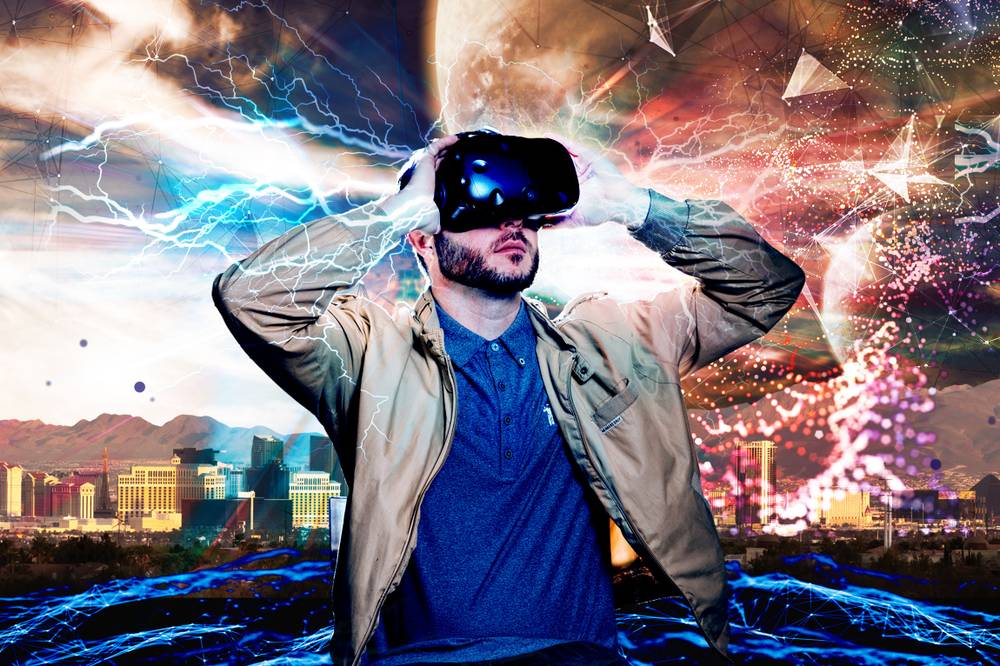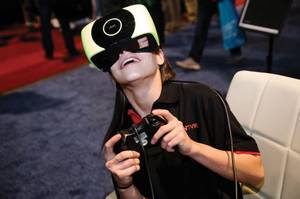"Go ahead, step off the balcony.” I’m high up in my fortress, looking across the courtyard, then down at the precipitous drop below me. I know that if I step off the edge, I won’t really fall. Actually, I don’t know what might happen. The digital world I’m inhabiting looks real enough to make me hesitant to move forward.
Max Curtis, just a few steps away, reassures me through my headphones. We’re inside not a fortress, but the ESports lounge (aka the Commissary) at Downtown Grand, and I’m trying out the HTC Vive virtual reality system, comprised of a headset and two controllers.
I finally lift one foot off the edge and into the air, like Indiana Jones taking a leap of faith. I feel it hit the Commissary floor, though what I actually see is myself hovering over the courtyard. Wow—now I want to fly.
That comes five minutes later, after I succumb to the enemy invaders of Longbow (one of eight options among the suite of games known as The Lab), and once Curtis switches my headset programming to Google Earth. Soon, I’m soaring over Yosemite National Park, then whizzing up, down and over the various streets of Downtown Manhattan like Spider-Man. When I select the Burning Man option, glide over to Center Camp and find myself surrounded by costumed revelers, I experience flashbacks to my 2010 burn. It feels like I’m back at Black Rock Desert.
This particular Vive headset is the newest amenity at the gamer clubhouse; on certain days, anyone can demo one of the hottest pieces of technology in the world for free. Curtis calls it a “bonus” and an extension of the Grand’s hospitality offerings. “What we’re trying to do here at the Commissary is improve the guest experience. We’re running an official esports project; we do real tournaments that are sanctioned … but we’re also really focused on anyone coming in here, enjoying their time, and doing something unique and interesting.”
Fresh from my adventures in the artificial world, I begin to see the potential of virtual reality as a casino offering. But as I envision a Strip full of VR arcades and goggled tourists, I ponder the city itself. Isn’t Las Vegas already a sensorial, fantasy-enabling escape? Can it be a virtual reality playground when it’s also the most famous adult playground in the real world? Can Vegas work in the virtual one?
We’re about to find out, for as goes the world, so goes Las Vegas. And right now, virtual reality is transitioning from being a symbol of the future to a phenomenon of the present. Gone are the clunky, imperfect—and expensive—gadgets of the 1990s and 2000s. Now your local big box regularly moves its stock of sleek and transporting—and somewhat-less-expensive—hardware, like the Vive, the Oculus Rift, Samsung’s Gear VR and Google’s Daydream View, to name a few. With technology—and content—improving and prices inching downward, a commercial breakthrough feels imminent. In 2017, the virtual and augmented reality market reached $14 billion in sales. That’s predicted to rise to $143 billion in just three years.
Nowhere in Las Vegas has virtual reality’s ascendancy been more obvious than at CES, which has been showcasing the medium for years. Earlier this month, multiple blocks of exhibition floor space at both the Las Vegas and Sands convention centers were devoted to emerging VR technology, from 360-degree digital cameras to simulation apparatus to a widening variety of headgear. At the massive Qualcomm and Samsung displays, attendees queued up for pop-up attractions that would put them in space or on a wild ride. And numerous panels addressed the various facets of VR.
During one, a question was posed: What is virtual reality’s potential in Las Vegas? Two panelists gave bullish answers centered around fun, location-based experiences. But another, HTC’s senior vice president of virtual reality Rikard Steiber, revealed his skepticism: “The taxi driver asked me when I came into Vegas if I was going to walk the dark side, the bright side or was I here for business? In VR, you can go anywhere, you can be anyone or you can do anything. So I think Las Vegas is going to have some competition.”
Vegas would seem to disagree. “I think VR can enhance Las Vegas, but I don’t think it could compete,” says Cathy Tull, chief marketing officer for the Las Vegas Convention and Visitors Authority. “Ziplining on Fremont Street is very different than experiencing it on a VR app. Dining at a restaurant or going to show is going to be a very different sensory experience when you’re actively participating. VR can bridge the gap of knowledge, but it can’t take the place of the product.”
Robert Rippee, director of the esports and hospitality labs at UNLV, also says VR can complement Las Vegas—and only up to a point. “It’s pretty good; your brain is fooled,” he says. “You thought you were experiencing something you weren’t. The difference between VR and the physical experience in Las Vegas is, [VR is] still missing four other senses. Until it reaches that state ... it’s still just a visual experience. The excitement [and] energy inside one of the big resorts and the music playing and the great smells of the great restaurants—those are part of the experience here. They aren’t threatened by VR.”
But VR content is compelling enough to market Las Vegas, one of the dominant ways the city uses the technology—and rightly so, given the billions of tourism dollars at stake. According to Tull, approximately two-thirds of U.S. travelers said they could be convinced to visit a destination if experienced first through virtual reality. So LVCVA launched its Vegas VR app, which boasts interactive videos of signature Vegas experiences that don’t require a fancy headset to view. You can fly over the Strip in a helicopter, watch the preparation of absinthe service at Aria’s Sage or get a dizzying view of Mystère’s acrobats, all convincingly filmed in 360 degrees. “From a marketing perspective, it’s a way for people to decide what they want to do,” Tull says. “People can find Vegas overwhelming.”
And it just so happens that once they arrive in Vegas, a few of their options also include virtual reality. Attractions are the most popular form of VR used outside the home. Amusement centers and theme parks have been rapidly incorporating its technology over the past few years, especially as a way of revitalizing older roller coasters. New York-New York will follow suit on February 7, when it begins offering a VR upgrade to its 21-year-old Big Apple coaster.
In 2016, Caesars’ Linq Promenade opened VR Adventures, which offers four distinct experiences, including a roller coaster POV video come to life, a race car simulation and a highly interactive zombie shooter game, all using the HTC Vive, which requires a computer to run the Steam VR software. “Our basic philosophy is that we look for things people can’t do at their house or on their own,” says Robert Wagner, operations manager at VR Adventures. “People aren’t going to buy a $7,000 motion chair to ride roller coasters.” And they might ride VR Adventures’ motion chair if they can’t handle actual roller coasters.
Last year, MGM Grand debuted the Zero Latency VR arena at its alternative gaming lounge Level Up, offering the newer, highly coveted multiplayer gaming experience. “We like to do things first, with whatever the customer wants,” says Lovell Walker, executive director of interactive gaming development for MGM Resorts. “We know Silicon Valley is the one manufacturing a lot of the goods, but we want to create a brand where we are building entertainment. When we think of what MGM Resorts represents, VR is at the top of the line in that discussion, along with our shows and gaming and other [amenities].”
And more VR is headed our way, including the Void’s Star Wars: Secrets of the Empire experience, due later this year at the Venetian, featuring untethered Oculus Rift equipment that fully immerses up to four participants in the Star Wars universe. It has already debuted at Disneyland and Walt Disney World to rave reviews; no less than five speakers at the three VR panels I attended at CES sung the glorified arcade game’s praises as both an attraction and as a technological forerunner.
If this year’s CES made any definitive statement on virtual reality, it’s that current technology can’t fully realize VR’s potential. Future developments have a greater chance of impacting more industries—including some key for Las Vegas tourism.
Take sports, a new revenue driver for the Valley, thanks to the debut of the Vegas Golden Knights and the subsequent acquisition of other professional teams. Intel’s CES presentations two weeks ago leaned heavily on its VR sports content, including highly interactive, multi-perspective, 360-degree streaming content planned for this year’s Winter Olympics and down the line for Major League Baseball, the National Basketball Association and the National Football League. It’s not crazy to assume that within a few years, we’ll be sitting in the cheap seats at T-Mobile Arena—or inside our home—watching the Knights, but our vantage point will be up close and center ice—or maybe even from the Knights’ bench, putting you right next to Deryk Engelland—once we put on our VR glasses. That potential timeline could also line up with the Raiders’ first year in Las Vegas.
This same approach to multi-view spectator events can also be applied to live concerts, the main driver at local box offices since the proliferation of artist residencies and the opening of new venues across the tourist corridor. “Let’s say you go to Britney or Celine or one of those performers,” Rippee says. “You could pay for a ticket and have a wonderful experience. You could also [use] VR and have a different perspective, like being onstage, or being one of the dancers. It’s not just your own perspective—you can see the perspective of the performer. That’s where there’s room to explore new content that would be complementary to existing forms of entertainment.”
And, as Curtis pointed out back at the Commissary, VR carries great potential with regard to hospitality. Walker and MGM agree, as does Rippee. “Let’s say it’s your first time here,” Rippee says. “You don’t know really where to go. You go to the concierge desk, but typically there’s a line of people waiting. They can only engage with one person at a time, maybe 30 guests per hour. VR would enable service elements to expand greatly, to give information at a deeper level. You put on your headset, say, ‘I want to go to the best Italian restaurant in Las Vegas,’ and you’re talking to a virtual concierge—rather than looking it up on Google—and engaging in actual conversation. If we can increase that engagement, you’ll have happier customers.”
Other realms carry great promise for VR integration into the resorts, like esports (MGM will include virtual reality with its new Esports Arena, slated to open in March at Luxor), while the fusion into others—like gambling—remain more nebulous, or at least at the mercy of developer and demographic whims.
But this raises the question: How VR might affect our everyday, off-Strip lives? It’s a considerable list. Las Vegans might start visiting VR centers in movie theaters aimed at complementing big-screen releases; traveling virtually to Greece as part of K-12 school curriculum, to see how ancient architects dreamt up the Acropolis; trying out every color, via goggles, for the car they’re considering buying; taking virtual tours of their new homes during consultations with interior designers and real estate agents; viewing 360-degree 3D images of their bones after MRI or CAT scans; working out to fitness-based video games that improve upon Wii Fit; learning to drive through a vehicular simulator; entering a workplace where every desk setup has a VR headset; or undergoing empathy training by viewing real-life footage of the impoverished.
But, to quote Axl Rose, all we need is just a little patience. It’s still early in virtual reality’s so-called second wave. The technology must evolve closer to reality. The hardware needs to become more accessible, less expensive and just plain wireless (2018 will be “the year VR goes wireless,” said more than one panelist at CES, and the unveiling of products at the convention strengthens their claim). Content has to be churned out more prolifically, but not as the expense of authenticity and narrative—or consumers might feel less compelled to undergo the VR learning curve.
There’s also the emergence of augmented reality—a mix of real-world views with superimposed graphics or information; the Pokemon Go mobile game is a frequently cited example—which some predict could become even bigger than virtual reality. Lovell and MGM are currently weighing it against VR as they strategize how the properties will forge relationships with their clientele. As Fake Love director of new business Jared van Fleet declared during a CES panel on VR and hospitality, “It would be foolhardy for any company to not think how their future audience will interact with their products.”
And interaction leads to experiences, those things the coveted millennial generation values above money and material things. Which is why, in a city that allows you to do nearly anything you want, the role of virtual reality can’t be underestimated. Just consider the mutual benefits. Imagine wearing a GoPro camera to capture your Vegas adventures. You turn it into VR content, upload it onto the ’net. You’ve got a potential viral hit on YouTube, and an enhanced memory of your trip. Naturally, it also promotes what the city has to offer.
You see, not only can Vegas be virtual, but the virtual can be Vegas.







